100 years Einstein Tower - A solar observatory connects art and science

The Einstein Tower over the course of time. The tower can only be preserved thanks to constant, extensive renovation work and generous donations.
Credit: Bildarchiv Foto Marburg, AIP Archiv, Brandenburgisches Landesamt für Denkmalpflege und Archäologisches Landesmuseum (Staatliche Museen zu Berlin, Kunstbibliothek), Wolfgang Reuss, Jannis Wiebusch, Thomas Wolf / Wüstenrot StiftungMore information about the Einstein Tower:
Planning and construction of the Einstein Tower
The Einstein Tower is the first important building by architect Erich Mendelsohn. It was built between 1919 and 1924 under the direction of the astronomer Erwin Finlay Freundlich in collaboration with the physicist Albert Einstein and . The tower is a functional building that represents one of the rare links between science and art. Mendelsohn succeeded in fulfilling both the requirements of science and his own ideas on design.
On 6 December 1924, the Einstein Tower was officially opened during a meeting of the Einstein Foundation's Board of Trustees. The solar observatory was the most important scientific solar telescope in Europe until the Second World War.
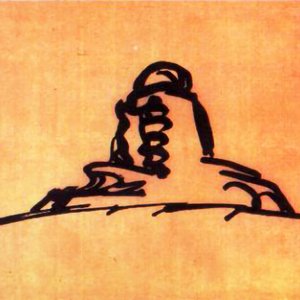
One of architect Erich Mendelsohn's sketches of the Einstein Tower, around 1920.
Credit: AIP Archive
Floor plans of the Einstein Tower. The red areas are brickwork, green reinforced concrete.
Credit: AIP Archiv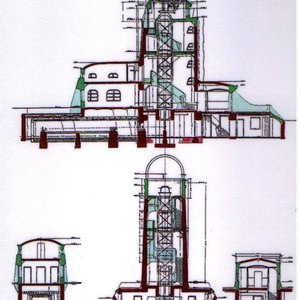
Section through the Einstein Tower
Credit: AIP Archive
Aerial view - Construction of the Einstein Tower at the Telegrafenberg, 1920. The Great Refractor, inaugurated in 1899, can be seen in the centre of the picture. Behind the Great Refractor is today's Michelsonhaus, the former main building of the Astrophysical Observatory Potsdam. The construction site of the Einstein Tower is visible in the foreground.
Credit: AIP Archive
The scaffolded Einstein Tower in 1921. Here you can see the brickwork at the lower levels of the tower, which is going to be plastered.
Credit: AIP Archive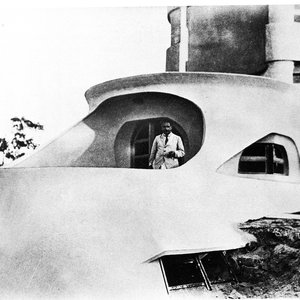
Albert Einstein 1921 in front of the Einstein Tower.
Credit: AIP Archive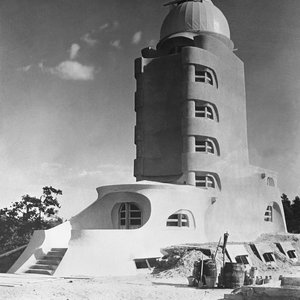
The Einstein Tower after completion of the shell of the building in 1921
Credit: Bildarchiv Foto MarburgDestruction during the World War II
In 1942, the tower was coated with a dark green and brownish mottled camouflage paint to prevent it from being a target during air raids. On 14 April 1945, an air mine exploded in the immediate vicinity. A fire broke out in the Einstein Tower, which was extinguished by an employee of the Astrophysical Observatory Potsdam (a predecessor institution of the Leibniz Institute for Astrophysics Potsdam), who spent the night in the workroom in the tower during the night of the bombing. The blast wave from the bomb also damaged the Einstein Tower. Two thirds of the dome was destroyed. The window sashes were torn out. There were splinter holes in the terrace and on the north side of the tower. The electrical cables were damaged. However, the tower's statics withstood the blast wave, which was confirmed by an examination of the tower in 1995 before the first major repair.
After the end of the war, the dome was provisionally renovated and work resumed at the beginning of October 1945. On the occasion of the 250th anniversary of the German Academy of Sciences in 1950, the building was thoroughly repaired.
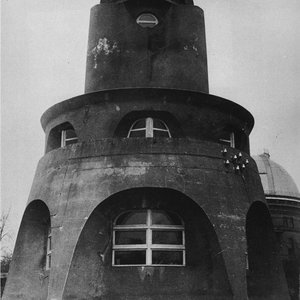
During the Second World War, the Einstein Tower got a dark camouflage coating as protection.
Credit: AIP Archive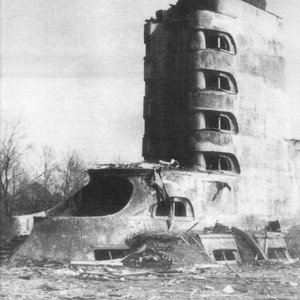
The Einstein Tower was badly damaged by a bomb that hit between the Great Refractor and the Einstein Tower during the Second World War.
Credit: AIP Archive
Damage to the Einstein Tower during the Second World War
Credit: AIP ArchiveRenovation of the Einstein Tower
Due to its mixed construction of brickwork and concrete, the Einstein Tower is susceptible to cracks through which moisture can penetrate. As a result, renovation work was necessary about every 10 to 15 years. In the 1990s, the Wüstenrot Foundation not only enabled the Einstein Tower to be fundamentally renovated, but also financed the first comprehensive structural and historical examination of the building since its construction. Between 2021 and 2023, the Einstein Tower was due for another refurbishment, which was again conducted and financed by the Wüstenrot Foundation.
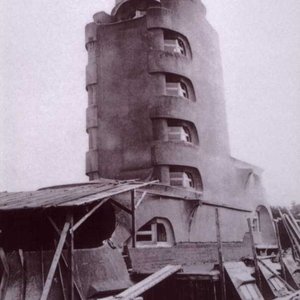
The first repairs were necessary as early as 1927.
Credit: AIP Archive
Detail of the Einstein Tower in need of renovation, 1964.
Credit: AIP Archive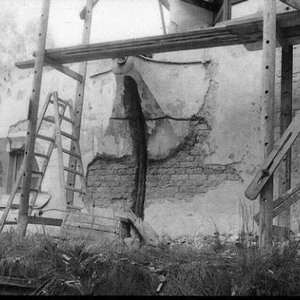
Renovation work in the 1970s.
Credit: AIP Archive
South view of the Einstein Tower, 1995.
Credit: AIP Archive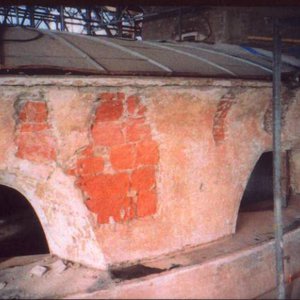
During the renovation in 1997-1999. The plaster had to be renewed in places.
Credit: AIP/R. Arlt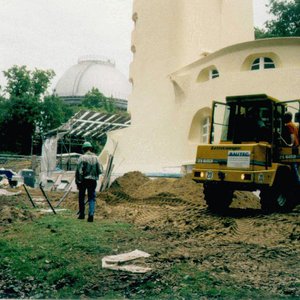
During the refurbishment in 1999, the outside facilities of the Einstein Tower were also renewed.
Credit: AIP/R. Arlt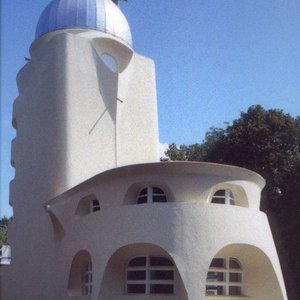
The newly renovated Einstein Tower in 1999, south view.
Credit: AIP/R. Arlt
The Einstein Tower in December 2020, showing the typical damage: damp patches in the walls, cracks in the plaster and in the terrace parapet.
Credit: Thomas Wolf © Wüstenrot Stiftung
Scaffolding around the Einstein Tower in July 2022.
Credit: AIP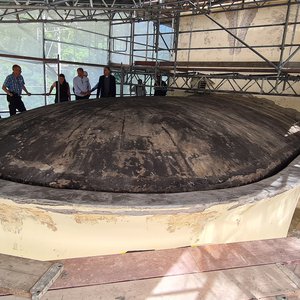
Assessment of the damage to the plaster and roof of the Einstein Tower during the 2022 refurbishment
Credit: AIP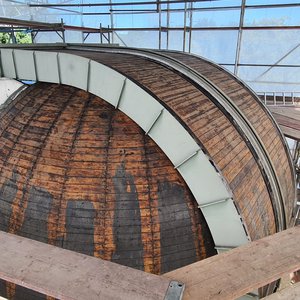
The dome of the Einstein Tower before renovation, 2022.
Credit: AIPHighlights from its history
In its hundred-year history, the Einstein Tower has experienced a number of highlights, including the visit of cosmonauts Sigmund Jähn and Calerie Bykowski in 1979, the royal visit of Prince Charles in 2009 and, more recently, a visit from the Nepalese president. The building has served as the backdrop for various ceremonies and cultural events, e.g. the production of ‘DAS NETZ’, and is still a world-famous visitor attraction to this day.
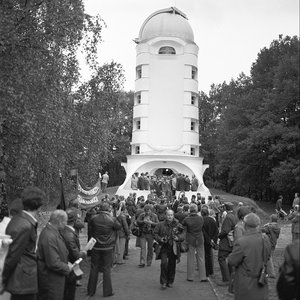
The two cosmonauts Sigmund Jähn and Valeri Bykowski descend the stairs of the newly renovated Einstein Tower in September 1979.
Credit: AIP Archive
Karl-Heinz Marek (Head of the Remote Sensing Department at the Central Institute of Earth Physics) and Sigmund Jähn in front of the Einstein Tower in 1983 on the occasion of the award of his doctorate.
Credit: Deutsches GeoForschungsZentrum GFZ
The famous physicist Carl Friedrich von Weizsäcker visiting the Einstein Tower in 1997.
Credit: AIP Archive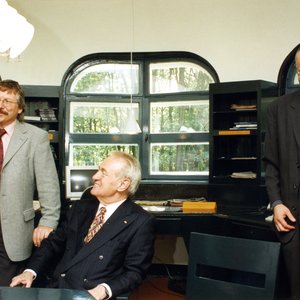
The then Federal President Johannes Rau in the meeting room of the Einstein Tower, 1999.
Credit: AIP Archive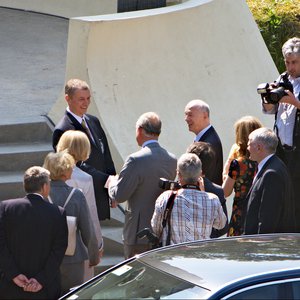
The Scientific Chairman of the AIP Matthias Steinmetz welcomes Prince Charles at the Einstein Tower, May 2009.
Credit: AIP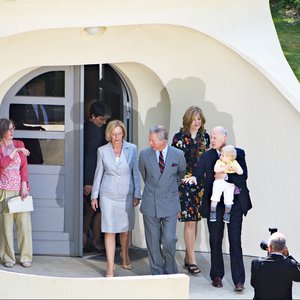
Prince Charles and the then Minister of Brandenburg Johanna Wanka leave the Einstein Tower.
Credit: AIP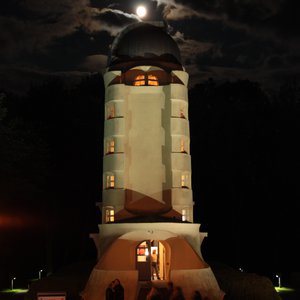
The Einstein Tower can often be visited during the Long Night of Science, here in June 2012.
Credit: AIP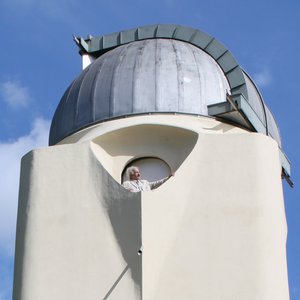
An actor as Albert Einstein on the Einstein Tower during filming for an arte documentary, May 2015
Credit: AIP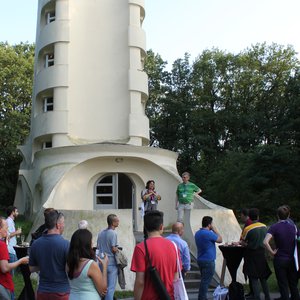
Reception at the Einstein Tower at the start of Symposium 334 of the International Astronomical Union in July 2017.
Credit: AIP
Klaus G. Strassmeier, Director of Research Branch I at the AIP, with the then French Ambassador Anne-Marie Descôtes in front of the Einstein Tower, January 2018
Credit: AIP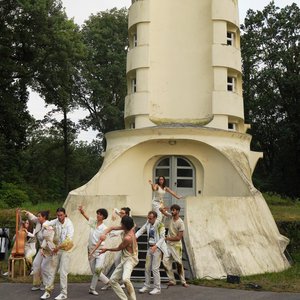
Scientists and artists told stories, sang, danced, made music and guided through the ‘Albert Einstein’ Science Park on Potsdam's Telegrafenberg, with the Einstein Tower as the highlight, for the performative event ‘DAS NETZ’, directed by Philip Baumgarten, in Summer 2021.
Credit: AIP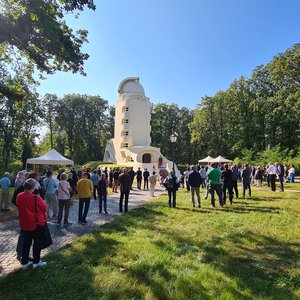
Many visitors attended the reopening ceremony of the Einstein Tower in September 2023 following the completion of the latest renovation work.
Credit: AIP
Ceremonial reopening of the Einstein Tower 2023 with Prof. Dr. Matthias Steinmetz, Mike Schubert, Joachim E. Schielke, Wolfram Rosenbach, Dr. Manja Schüle, Prof. Philip Kurz and Prof. Dr. Klaus Strassmeier.
Credit: AIP/ Thomas Spikermann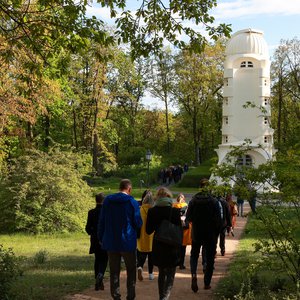
The Einstein Tower was also a highlight of the Digital Ministers' Conference in April 2024.
Credit: V. Tanner
Guests at the Einstein Tower in June 2024: Nepalese President Paudel with his wife and his delegation as well as the host research institutions GFZ, AIP, PIK and RIFS.
Credit: Reinhardt und SommerScience at the Einstein Tower as a solar observatory
The commissioning of the Einstein Tower in 1924 marked the beginning of a new era of modern solar research in Potsdam and Germany. The tower remained the largest solar research facility in Europe until the Second World War and was one of the most powerful facilities of its kind in the world. The Einstein Tower was originally built to provide evidence of the redshift of spectral lines in the gravitational field of the Sun predicted by Einstein's theory of relativity. However, turbulence on the surface of the Sun produces a blue shift of the same magnitude and superimposes the predicted effect, so that the observations remained inconclusive. Experimental confirmation of the effect was not achieved until the end of the 1950s.
In the centre of the building, a vertically fixed telescope with a lens of 60 cm diameter and 14 m focal length stands on its own foundation. A coelostat is located in the dome, whose two mirrors direct the sunlight into the telescope to the lens objective in the wooden tower. In the basement, the light is directed horizontally into the laboratory through another swivelling mirror. Its centrepiece is the spectrograph room, which is also around 14 m long and extends to the end of the earth wall on the south side of the tower. In this temperature-stabilised room, sunlight is broken down into its spectral components and analysed in order to obtain information about temperature, pressure, magnetic fields, eruptions and other physical processes and conditions on the Sun, in particular its outer layers.
Erwin Finley Freundlich used the Einstein Tower as a starting point for several expeditions to solar eclipses. On his trip to Sumatra in 1929 to see the solar eclipse, Walter Grotrian recorded the spectrum of the solar corona with his own device. In the following years, his analyses of the measurements revealed that the solar corona has a temperature of more than one million degrees Celsius. Grotrian also created a model of the physical nature of sunspots at the Einstein Tower. Harald von Klüber, one of Freundlich's early colleagues, developed a way of analysing the strength and direction of the magnetic field in sunspots. Another example of scientific success at the Einstein Tower is Horst Künzel's work on delta sunspots, published in 1960, which is still important for predicting radiation eruptions on the Sun.
Between 1943 and the mid-1980s, photographs of the Sun were taken at the Einstein Tower on glass photographic plates, on which in particular the dark sunspots can be seen. The approximately 3000 glass plates are stored in the Einstein Tower and have been digitised and published in the historical plate archive.
Today, the Einstein Tower is the AIP's in-house instrument for solar observations. Its still fully functional equipment enables participation in international measurement campaigns and long-term measurements. In particular, polarisation measurements of sunspots are carried out to investigate the magnetic and velocity field on the surface of the Sun. Researchers at the AIP also use the Einstein Tower to develop and test new experiments and devices before installing them on large-scale equipment such as the GREGOR telescope on Tenerife and to train students.
Among other things, parts of the instruments for the European Space Agency's (ESA) Solar Orbiter space probe, which was launched into space from Cape Canaveral in Florida on 9 February 2020 to study the Sun at close range, were developed in the Einstein Tower. On board the space probe is the STIX X-ray telescope, which was co-developed, tested and optimised at the Einstein Tower. A part of this telescope is still set up as a simulation in the laboratory of the Einstein Tower in order to be able to check the measurement results of Solar Orbiter.
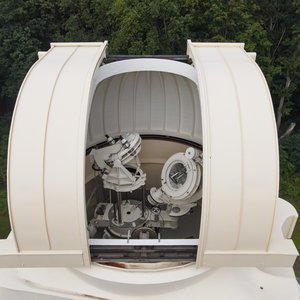
For observations, the dome is turned towards the Sun and the slit is opened.
Credit: Thomas Wolf © Wüstenrot Stiftung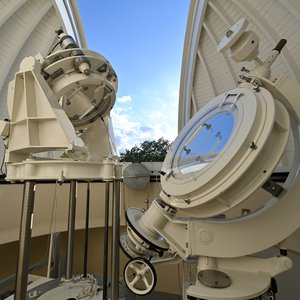
The coelostat in the dome of the Einstein Tower captures the light of the Sun.
Credit: Thomas Wolf © Wüstenrot Stiftung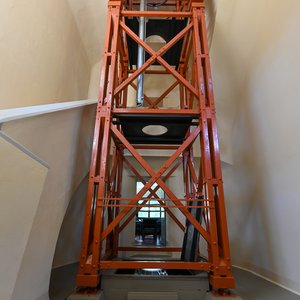
The wooden tower carries the mirror and the lens of the telescope.
Credit: Thomas Wolf © Wüstenrot Stiftung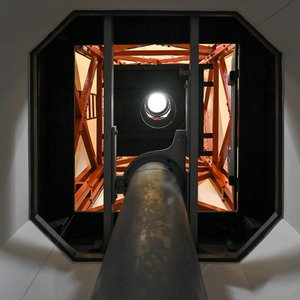
View from the floor of the tower to the dome
Credit: Thomas Wolf © Wüstenrot Stiftung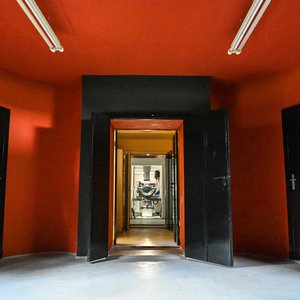
The mirror at the bottom of the tower directs the light from the coelostat to the spectrograph room.
Credit: Thomas Wolf © Wüstenrot Stiftung
Image of the Sun in front of the inner laboratory
Credit: Thomas Wolf © Wüstenrot Stiftung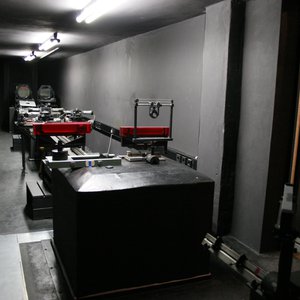
The dark spectrograph room in the basement of the Einstein Tower. Here the sunlight is split up into its colour components for further analysis.
Credit: AIP/J. Rendtel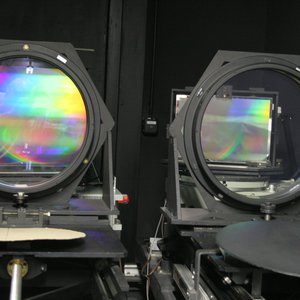
Collimation objectives of the double spectrograph in the basement laboratory of the Einstein Tower.
Credit: AIP/J. Rendtel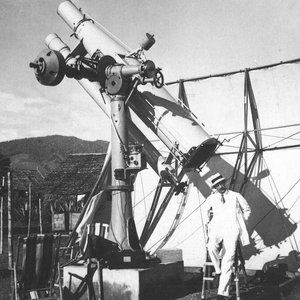
Erwin Finley Freundlich, Director of the Einstein Tower, on the Sumatra expedition for the solar eclipse in 1929
Credit: AIP Archive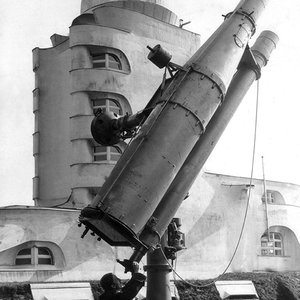
Harald von Klüber in 1932 at an astrograph for photographing solar eclipses in front of the Einstein Tower.
Credit: ullstein bild – Sasha Stone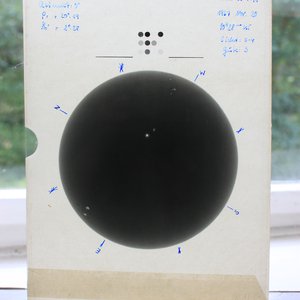
A photo plate from the Einstein Tower from 1967. The digitized plates are now available in the historical data archive public.aip.de/historical-sky.
Credit: AIP
Images from the Solar Orbiter Mission in July 2020, which was also prepared at the Einstein Tower. Numerous small bursts of radiation, named ‘nano-flares’ are visible.
Credit: Solar Orbiter/EUI Team (ESA & NASA); CSL, IAS, MPS, PMOD/WRC, ROB, UCL/MSSLThe Einstein Tower today
After renovation and reopening in September 2023, the Einstein Tower is once again fully operational as a solar observatory. In order not to interfere with scientific activities, interior tours are only possible as part of guided tours and on special occasions.

The Einstein Tower in the Science Park "Albert Einstein" at the Telegrafenberg in Potsdam.
Credit: Thomas Wolf © Wüstenrot Stiftung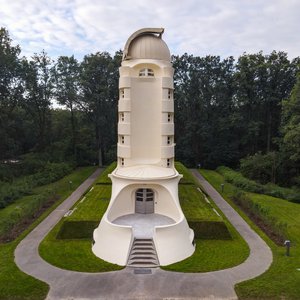
Front view of the Einstein Tower
Credit: Thomas Wolf © Wüstenrot Stiftung
South view of the Einstein Tower. The laboratory with the spectrograph room is located below the grass-covered hill.
Credit: Thomas Wolf © Wüstenrot Stiftung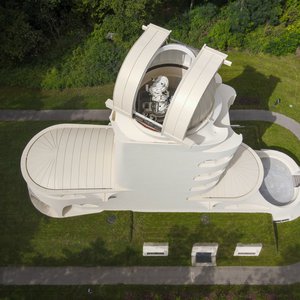
View from above at the optics in the opened dome
Credit: Thomas Wolf © Wüstenrot Stiftung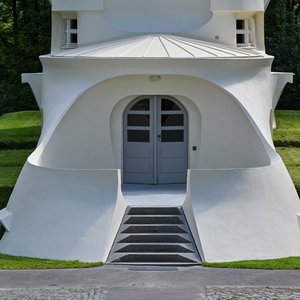
Entrance staircase of the Einstein Tower
Credit: Thomas Wolf © Wüstenrot Stiftung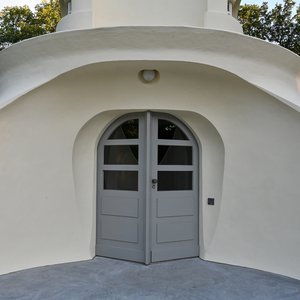
The entrance door to the Einstein Tower
Credit: Thomas Wolf © Wüstenrot Stiftung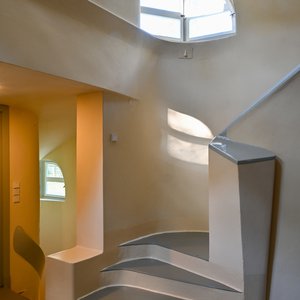
Stairs inside the Einstein Tower.
Credit: Thomas Wolf © Wüstenrot Stiftung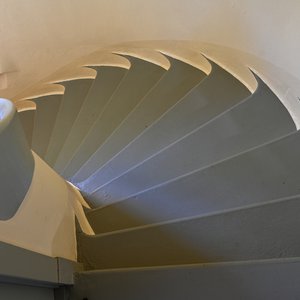
Stair case in the Einstein Tower
Credit: Thomas Wolf © Wüstenrot Stiftung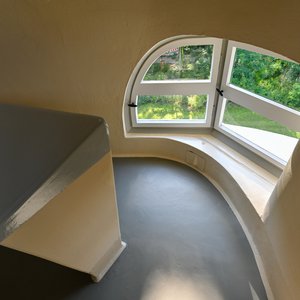
The small, sweeping windows are typical of the organic shape of the Einstein Tower.
Credit: Thomas Wolf © Wüstenrot Stiftung
Meeting room in the Einstein Tower.
Credit: Thomas Wolf © Wüstenrot Stiftung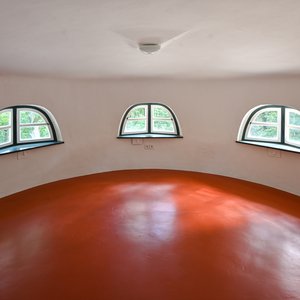
The small room in the Einstein Tower above the meeting room.
Credit: Thomas Wolf © Wüstenrot Stiftung
The large room in the basement was given a coat of red paint and is used as an exhibition space for public events.
Credit: Thomas Wolf © Wüstenrot Stiftung
Water drainage at the Einstein Tower. Rainwater and dampness in the walls cause problems time and again.
Credit: Thomas Wolf © Wüstenrot Stiftung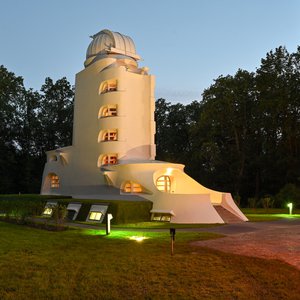
Evening at the Einstein Tower
Credit: Thomas Wolf © Wüstenrot Stiftung
The Einstein Tower (left) and the Great Refractor (right) at the Telegrafenberg, Potsdam.
Credit: Thomas Wolf © Wüstenrot Stiftung